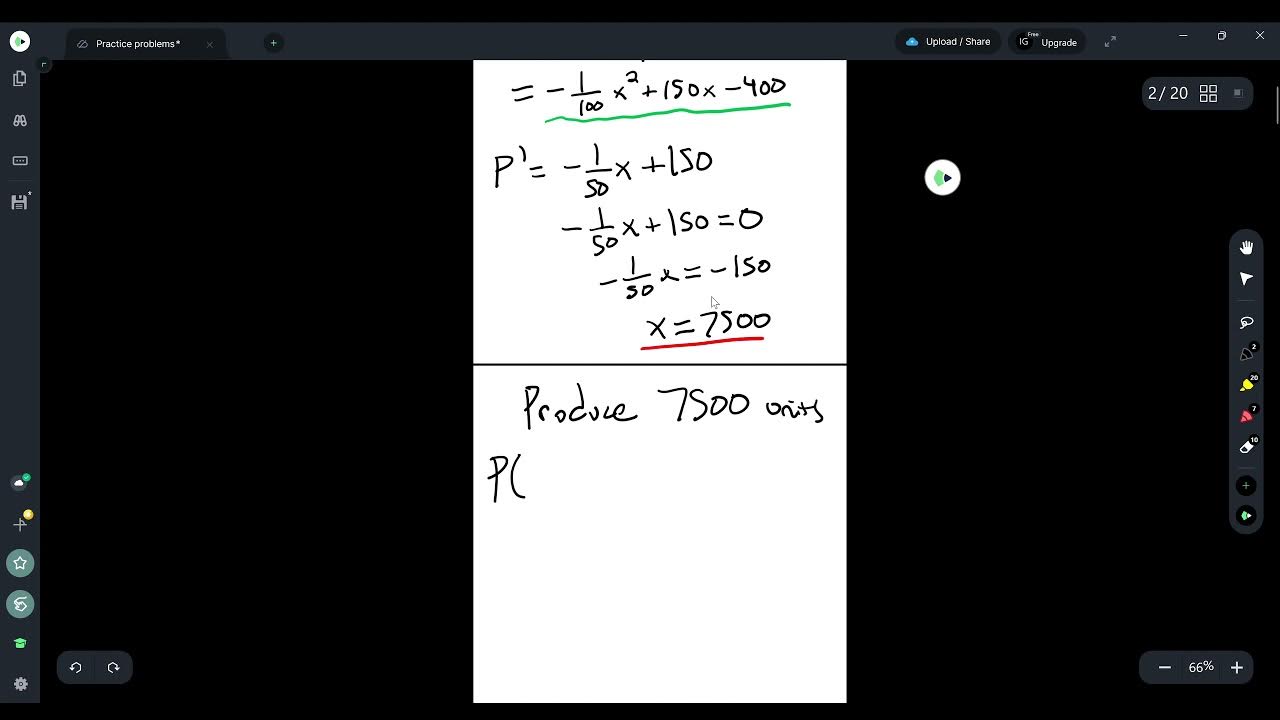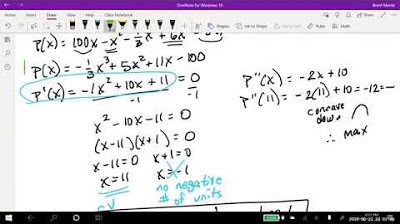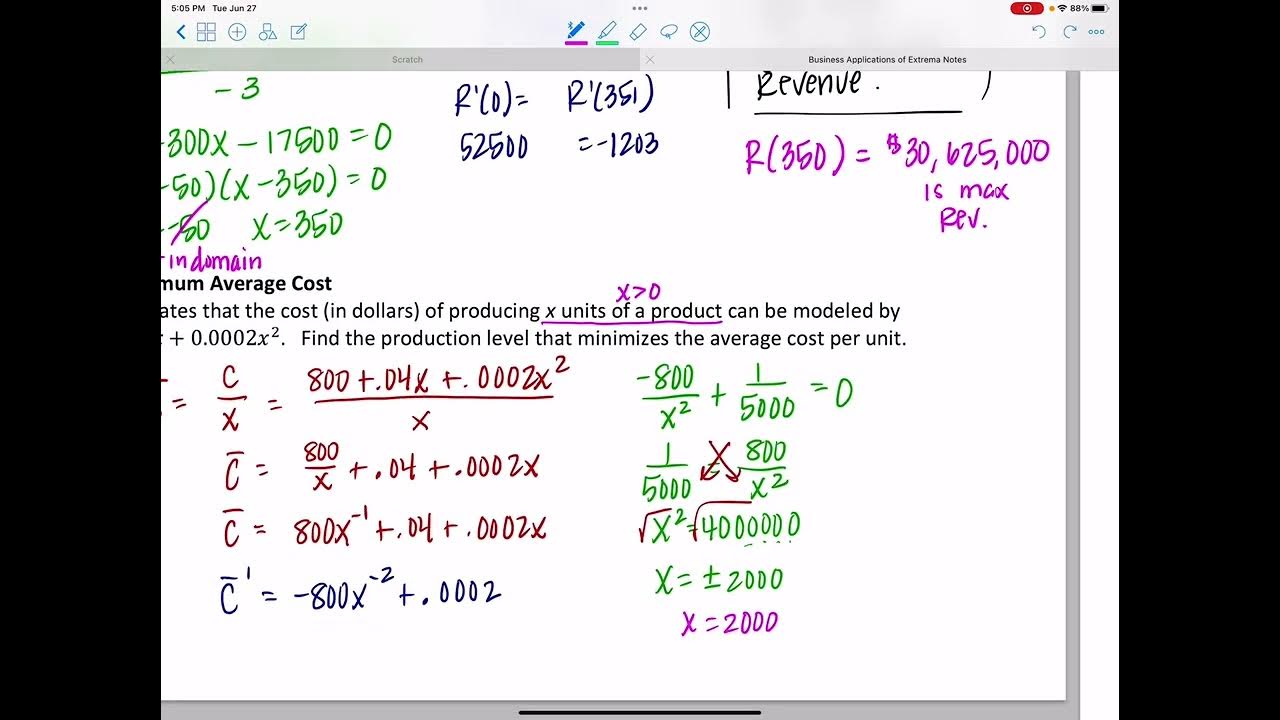Optimization: profit | Applications of derivatives | AP Calculus AB | Khan Academy
TLDRIn the video script, the presenter discusses optimizing profit for a shoe factory by determining the optimal number of thousands of pairs to produce. They introduce a revenue function based on a wholesaler's offer and a cost function provided by consultants. Using calculus, the presenter finds critical points to maximize profit, solving a quadratic equation for x and applying the second derivative test to confirm a maximum profit point at 3,528 pairs, resulting in a profit of $13,128.
Takeaways
- 👟 The script discusses the optimization of profit for a shoe factory by determining the optimal number of thousands of pairs of shoes to produce.
- 📈 The revenue function is given as 10 times x, where x represents thousands of pairs of shoes produced, and revenue is in thousands of dollars.
- 💰 The cost function is a cubic function of x, which includes terms for the cube, square, and linear components of the number of shoes produced, also in thousands of dollars.
- 🔍 Profit is calculated by subtracting the cost function from the revenue function, aiming to find the maximum profit point.
- 📚 The critical points of the profit function are found by setting its first derivative equal to zero, which simplifies to solving a quadratic equation.
- 🔢 The quadratic formula is used to find the potential critical points, resulting in two possible values for x.
- 📉 The second derivative test is applied to determine whether the critical points are maximum or minimum points, using the concavity of the function.
- 📈 The maximum profit point is identified as x = 3.528, indicating the optimal number of thousands of pairs to produce for maximum profit.
- 💡 The second derivative at the critical point of 3.528 is negative, indicating that the function is concave down and thus at a maximum there.
- 📝 The profit at the optimal production level (3,528 pairs) is calculated to be approximately $13,128, considering the profit function's value at x = 3.528.
- 🚀 The conclusion suggests that by producing 3,528 pairs of shoes, the shoe factory can achieve a profit of $13,128, optimizing their financial outcome.
Q & A
What is the main objective of the shoe factory owner in the script?
-The main objective of the shoe factory owner is to determine the optimal number of thousands of pairs of shoes to produce in order to maximize profit.
What is the revenue function for the shoe factory as described in the script?
-The revenue function is given by 10 times x, where x represents the thousands of pairs of shoes produced.
What are the components of the cost function for the shoe factory?
-The cost function is composed of the cube of the thousands of pairs produced, minus 6 times the square of the thousands of pairs produced, plus 15 times the thousands of pairs produced.
How is the profit function derived from the revenue and cost functions?
-The profit function is derived by subtracting the cost function from the revenue function, which is represented as 10x minus (x^3 - 6x^2 + 15x).
What is the first step in optimizing the profit function?
-The first step in optimizing the profit function is to find the critical points, which are determined by setting the first derivative of the profit function equal to zero.
What is the first derivative of the profit function?
-The first derivative of the profit function is -3x^2 + 12x - 5.
How does one determine whether a critical point is a maximum, minimum, or neither?
-The second derivative test is used to determine the nature of a critical point. If the second derivative at a critical point is less than 0, it indicates a maximum; if greater than 0, it indicates a minimum.
What is the second derivative of the profit function?
-The second derivative of the profit function is -6x + 12.
What are the critical points calculated for the profit function in the script?
-The critical points calculated are approximately 3.528 and 0.4725, which represent thousands of pairs of shoes.
How does the script determine the optimal number of shoes to produce for maximum profit?
-The script uses the second derivative test to determine that the critical point at 3.528 is a maximum, indicating that producing 3,528 pairs of shoes will yield the maximum profit.
What is the maximum profit calculated for producing 3,528 pairs of shoes?
-The maximum profit calculated for producing 3,528 pairs of shoes is approximately $13,128.
Outlines
👟 Starting a Shoe Factory
This paragraph introduces the scenario of opening a shoe factory and the challenge of determining the optimal production quantity for maximizing profit. It defines 'x' as the thousands of pairs of shoes produced and explains how to calculate revenue, given a wholesaler willing to pay $10 per pair. It also discusses the costs involved, including materials, factory construction, and operational expenses, which are expressed as a cubic function of x. The goal is to optimize profit, defined as revenue minus cost, through an analytical approach.
📈 Solving for Critical Points
The paragraph continues with the mathematical process of finding critical points of the profit function by setting its first derivative to zero. The quadratic formula is used to solve for x, resulting in two critical points: approximately 3.528 and 0.4725. These represent potential maximum and minimum points for profit. Calculations for both points are shown to determine their values.
🔍 Analyzing Concavity
This paragraph applies the second derivative test to determine the nature of the critical points. By evaluating the second derivative at 3.528 and 0.4725, it is concluded that the function is concave downwards at 3.528 (indicating a maximum) and concave upwards at 0.4725 (indicating a minimum). Hence, producing 3.528 thousand pairs of shoes (or 3,528 pairs) is optimal for maximizing profit.
Mindmap
Keywords
💡Revenue
💡Cost
💡Profit
💡Critical Points
💡Derivative
💡Quadratic Formula
💡Second Derivative Test
💡Concave Upwards/Downwards
💡Optimization
💡Wholesaler
💡Cubic Polynomial
Highlights
Introduction of the problem: optimizing profit for a shoe factory by determining the optimal number of thousands of pairs to produce.
Definition of x as the thousands of pairs of shoes produced.
Explanation of revenue function: revenue as a function of x, with a wholesaler willing to pay $10 per pair.
Calculation of revenue: 10x, where x is in thousands of pairs, translating to thousands of dollars.
Introduction of costs: materials, factory, employees, and electricity.
Cost function provided by consultants: cost as a function of x is x^3 - 6x^2 + 15x.
Definition of profit: profit as a function of x is revenue minus cost.
Simplification of the profit function: p(x) = 10x - (x^3 - 6x^2 + 15x) = -x^3 + 6x^2 - 5x.
Introduction of critical points: finding the derivative of the profit function to determine maximum and minimum points.
Calculation of the first derivative: p'(x) = -3x^2 + 12x - 5.
Solving for critical points: setting the first derivative to zero and solving the quadratic equation.
Calculation using the quadratic formula: x = 3.528 and x = 0.4725 as critical points.
Introduction of the second derivative test: p''(x) = -6x + 12.
Determination of concavity: p''(3.528) < 0 indicating a maximum, and p''(0.4725) > 0 indicating a minimum.
Calculation of maximum profit: substituting x = 3.528 back into the profit function yields a profit of approximately $13,128.
Transcripts
5.0 / 5 (0 votes)
Thanks for rating:





